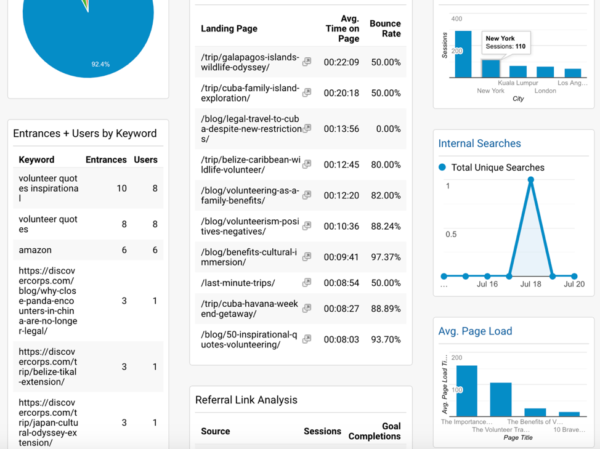Editor’s note: Given SEO’s role in content marketing and its rapid evolution, we updated this post on auditing your site.
Website content audits for SEO purposes have had a negative stigma associated with them for some time. They can be tedious, time consuming, and it can take time to see results, but they are necessary for driving website success.
Because of Google’s frequent algorithm updates and improvements, SEO rules and best practices are constantly changing. Reevaluating your SEO and your strategies is one of the only ways to stay on top of these changes and continue to move your website content forward.
An SEO website audit doesn’t have to be stressful or difficult, but it helps to have a plan before you and your team dive into this type of analysis. You need to know what you’re looking for, who is going to make what changes, and what tools are available to help you implement those changes.
An #SEO site audit doesn’t have to be stressful or difficult if you have a plan, says @ADiSilvestro. Click To TweetSteps, tools, and what to look for in an SEO audit
Before diving into an audit, know what you’re looking to learn from the analysis of your SEO performance data and what website content goals this information will help you accomplish. Once you have a list of your goals, you can create a checklist of items to identify and evaluate.
Collect your website content analytics
Going through and gathering all the data and analytics for your website content (traffic, keywords, referral traffic for each landing page, etc.) is key. Given that this data changes frequently, set up dashboards that make it easier to track it accurately for every audit you perform.
Below is an example of a custom dashboard I built for my company Discover Corps (learn how here) and the kind of SEO information you should add:


Once you have this report, you can slice and dice the data to find trends and areas that need help (more on that later).
Analyze your targeted keywords
Review the keywords you’re targeting and using most frequently in your content to identify any changes in their performance. You also should analyze them for relative value to your business compared to your competition. Conduct research on overall keyword performance trends to stay on top of the terms worth pursuing in the immediate future.
I recommended using the Google Keyword Planner to make this happen. Below is a screenshot that shows the type of information you can get from a tool like this. Because this data comes from your competitors, the competition is particularly interesting:
Click to enlarge
Track potential sitemap concerns (and make sure they are set up correctly and completely).
Creating an XML sitemap can help you make sure search engine bots are seeing what they should be and indexing and caching your pages quickly. As you want to make sure users see the most updated version of your pages, check your sitemaps regularly.
Create an XML sitemap to make sure search engines are indexing & caching your pages quickly, says @ADiSilvestro. Click To TweetBelow is a screenshot of a Google Search Console. In this case, I set up different sitemaps based on the areas of my website (landing pages, product “trip” pages, pages on site, and blog categories):
Click to enlarge
Unsure how to check your sitemaps or set a sitemap up correctly? Visit this article. You typically handle this through your web hosting company, such as GoDaddy or WP Engine.
Use a web hosting company such as @godaddy or @wpengine to set up or check a sitemap, says @ADiSilvestro. #tools Click To TweetLook for your indexed pages
Make sure all the pages are being indexed correctly and your best content is making the cut. Check this by typing site:www.domain.com into the search engine. You can see what content appears in the list of indexed content. This can be harder on a large website, but it’s healthy to check once per week.
TIP: You also can see indexed pages in Google Search Console where your sitemaps are housed.
Check for linking concerns on site
Obviously, make sure you don’t have any broken links on your website. Routinely go through and spot check internal links to make sure everything still works, especially on pages where your older content resides. It’s also important to have at least one or two internal links within all your content. This is good practice for creating a quality user experience, as well as for SEO.
A lot of free tools check for broken links on your site. I use Broken Link Check each quarter. It’s an easy tool that spits out the broken link and the page where it appears. Then I manually fix the link.
Check for linking concerns off site
A great way forward with this step is to use an SEO tool to help identify links on other sites pointing to your site. External sites using poor or broken links to your site can significantly impact your SEO. If you find this problem, ask the sites to remove or update them by contacting the publisher or using the Google disavow tool.
External sites using poor or broken links to your site can significantly impact your #SEO, says @ADiSilvestro. Click To TweetAs far as tools go, I use Ahrefs and have used SEMRush. However, tons are on the market. I recommend signing up for a few free trials, locking your price point down, and going from there.
HANDPICKED RELATED CONTENT:
Keep an eye on page speed and load times
Make sure your pages load quickly and completely so visitors aren’t turned away. Significantly improving your load times can require the work of a skilled developer. At the least, you should address the most obvious causes of slow load times. For example, make sure your images are compressed and optimized appropriately, and make sure they are severed in “next gen” formats. Take the big images loading on your pages and convert them from .jpg, .png, or .webp (you can use a free online image converter such as this). It’s time-consuming, but it’s one of the few things you can easily fix without the help of a developer – and we all need that every once in a while.
Check your load times with the tool Google PageSpeed Insights. Below is an example of what you’ll see. Notice you can see a score with suggestions for both mobile and desktop. Once again, I recommend taking care of the images as best you can, and then simply passing this list of tasks to a developer (expect that it could be complicated and time-consuming):

TIP: Always, always, always record everything you do. If you find an error on your website, always document it. You want to keep a record of things you changed and fixed so when you perform your next audit, you are reminded of what’s happened. Use a spreadsheet to note the dates, page URLs, errors, fixes, and the party responsible for each change.
In between #SEO audits, record any changes and fixes you perform on the site, says @ADiSilvestro. Click To TweetHANDPICKED RELATED CONTENT:
Why you need to perform regular SEO audits
I touched on it earlier, but it’s worth noting that an SEO website audit needs to be done regularly. A good rule of thumb is to perform an audit once per year, although I and others recommend at least two reviews per year. Among the reasons to commit to a regular audit:
- Algorithm updates and webmaster guidelines change.
- Content gets outdated quickly.
- Website errors, including broken links, can lead to a drop in traffic.
- Negative SEO and poor sites linking back to your site can be detrimental.
- SEO audits serve as a marker to know when something went wrong and how long it’s been going wrong. This can help you determine the cause of the problem.
Keep records of everything you do and it should only get easier and easier. It can take a long time to see SEO results, so the faster you can get on top of anything slowing your site the better.
Whether it’s you and your team performing the audit or an SEO agency, keep up with the process. The first audit might seem daunting, but I promise it gets easier and easier each year.
Have you ever completed an SEO website audit? What tips do you have for webmasters just starting out? Let us know your story and your thoughts in the comments.
You can get regular guidance to help grow your skills and your content marketing programs. Subscribe to the free CMI weekday newsletter.
Cover image by Joseph Kalinowski/Content Marketing Institute



